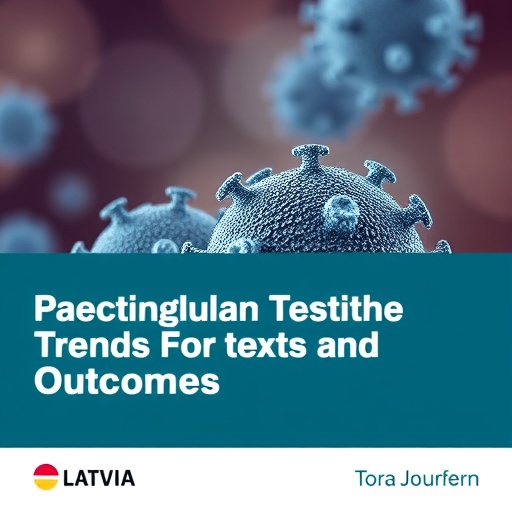Over the course of nearly a quarter-century, researchers in Latvia have documented critical shifts in the landscape of testicular cancer, highlighting crucial implications for regional healthcare strategies and patient outcomes. A comprehensive study spanning from 1994 to 2017 meticulously tracked incidence trends, mortality rates, and survival outcomes for this disease, providing a rare longitudinal glimpse into its evolving epidemiology within the Latvian population.
The investigation drew upon a robust cancer registry that recorded almost every diagnosed case in the country, ensuring a population-wide representation that reinforced the validity of its findings. By focusing on various patient demographics and clinical characteristics—including age, tumor histology, and disease staging based on the internationally recognized TNM classification system—researchers sought to identify nuanced patterns influencing both prognosis and treatment efficacy.
One of the most noteworthy revelations from this extensive analysis was the gradual but unmistakable rise in the incidence of testicular cancer. The age-standardized rate increased from 2.25 to 3.57 cases per 100,000 individuals over the study period, corresponding with an average annual percentage change of 2.37%. This uptick signals potential shifts in underlying risk factors or improvements in diagnostic detection that warrant further scientific scrutiny.
Delineating the disease subtypes yielded additional insights. Both seminoma and non-seminoma variants displayed substantial increases in incidence, with annual growth rates of approximately 3.2% and 4.1%, respectively. The wide confidence interval for non-seminoma accentuates the variability in its epidemiological behavior, suggesting that this subgroup may be influenced by distinct etiological or environmental factors requiring targeted research.
Despite the rising number of new diagnoses, mortality from testicular cancer in Latvia remained remarkably steady throughout the observation window. The annual percentage change in death rates hovered around 1.32% but lacked statistical significance, indicating no clear worsening or improvement in survival at the population level from a mortality perspective.
More encouragingly, survival analyses demonstrated significant advancements in patient outcomes over time. Five-year overall survival rates showed an impressive increase from just under 60% in the mid-1990s to over 80% by the 2010s. Similarly, specific survival attributable to testicular cancer rose by approximately 27 percentage points, underscoring meaningful progress in therapeutic interventions and disease management.
Long-term outlooks further corroborate these optimistic trends. Ten-year survival probabilities maintained relatively high levels, with cancer-specific survival around 74%, indicating that patients who survive the initial critical years often fare well over an extended period. This emphasizes the importance of early detection and sustained follow-up care in optimizing prognoses.
The combination of stable mortality and improving survival despite rising incidence suggests that Latvia’s healthcare system has enhanced its capability to diagnose and treat testicular cancer more effectively. However, the findings also highlight a potential gap: the lack of a fully integrated multidisciplinary approach to care may be limiting further gains in outcomes compared to other developed countries.
Advances in diagnostic imaging, surgical techniques, and chemotherapeutic regimens likely underlie much of the survival benefit observed. Moreover, increased awareness among clinicians and patients about testicular cancer’s symptoms and risks potentially facilitates earlier presentation and diagnosis, which are critical for favorable prognosis.
The study employed Joinpoint regression modeling, a statistical method adept at detecting changes in trend data, to quantify shifts in incidence and mortality. Complementing this, Kaplan-Meier survival analysis provided granular estimates of survival probabilities, reinforcing conclusions with robust statistical support.
Importantly, the persistent rise in testicular cancer incidence underscores the need for focused research to elucidate environmental, genetic, or lifestyle factors contributing to this pattern. Identifying modifiable risks could enable preventative strategies to curb future increases and alleviate healthcare burdens.
Healthcare policymakers in Latvia now face the challenge of leveraging these epidemiological insights to optimize patient pathways. Implementing multidisciplinary tumor boards integrating oncology, urology, radiology, and pathology expertise may help tailor treatment plans, promote guideline adherence, and foster clinical trial participation.
Furthermore, this comprehensive Latvian experience adds valuable data to the global understanding of testicular cancer dynamics. Comparing these trends across different populations elucidates the heterogeneous nature of the disease and the influence healthcare infrastructure exerts on outcomes.
In conclusion, this landmark 23-year study offers a compelling narrative of testicular cancer transformation in Latvia: a rising incidence juxtaposed against steady mortality and marked improvements in survival. It calls for sustained investment in integrated cancer care and further etiological research to ensure that all patients benefit from cutting-edge management approaches.
By integrating comprehensive data analysis with clinical interpretations, the study paves the way for future research endeavors and health policy reforms aimed at enhancing both quality of care and survival rates for testicular cancer patients—not only in Latvia but across wider international contexts.
Subject of Research: Epidemiology, incidence trends, mortality, and survival outcomes of testicular cancer in Latvia from 1994 to 2017.
Article Title: Testicular cancer in Latvia: incidence trends and prognostic outcomes across a 23-year study.
Article References:
Leonenko, K., Petrosina, E., Zolovs, M. et al. Testicular cancer in Latvia: incidence trends and prognostic outcomes across a 23-year study. BMC Cancer 25, 1474 (2025). https://doi.org/10.1186/s12885-025-14792-8
Image Credits: Scienmag.com




